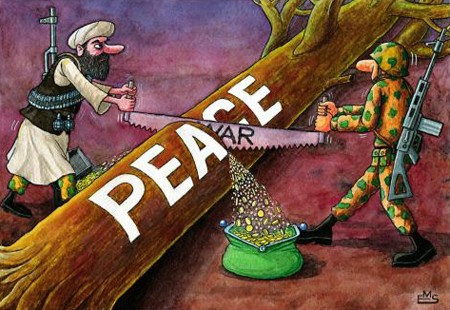
American troops intensify pressure on the Afghan city, but the Taliban retain strong influence.
The noose is tightening around Kandahar. The offensive announced with fanfare for July against the Taliban’s ancient stronghold has been pushed back until autumn. We don’t even speak of “military operations” anymore — a big word in the little manual of the new American doctrine of “counterinsurgency” — but of “processes.” It doesn’t help. Americans and Canadians continue to amass their troops outside the provincial capital. At the same time in the city of Kandahar, the Taliban refuse to disarm. “Terrorism continues everywhere in the city. But the Taliban have changed tactics. Presently, they indulge in targeted assassinations, suicide attacks, and planting homemade bombs along roads,” confided Ahmad Wali Karzai, the president of the provincial council and, incidentally, the half-brother of Afghan president Hamid Karzai.
Deserted Streets
As for the Kandaharis, they live in fear and disillusion. Almost nine years of foreign occupation has brought them neither peace nor security. Why, they ask? “The construction of schools, hospitals, roads? Countless pretty promises, never fulfilled,” bitterly fired Idriss, a young engineer who lives in the center of Kandahar, a few meters from the former residence of Mullah Omar. The spiritual leader of the Taliban is currently hiding in the Quetta region of Pakistan. Idriss remains certain that “the Americans have only one goal, to remain in Afghanistan.” To that end, he says, “They support the Taliban while pretending to combat them, solely to prolong the war.” He is not alone in believing this particular conspiracy theory. When we asked his opinion, Abdul, a small restaurant owner, shook his head in approbation. “It’s the same for the rural culture and drug trafficking,” he says. “Westerners pretend that it’s our leaders who are behind this; but, without American help, how can these enormous transactions, visible to everyone, continue to exist?”
In Kandahar’s center, the roads are nearly deserted. The city carries scars from recent attacks. On one of the city’s principal arteries, one can see one of the “fortified guesthouses” that shelters the western construction companies, its walls eviscerated. The building suffered a suicide bombing last spring. Four Afghans were killed, several Americans wounded. On 20 April, rebels detonated a donkey laden with explosives in an open-air market. Three children were killed but the Taliban claimed responsibility for the death of eleven foreigners.
Bad Governance
Three days ago, a man in Kandahar was shot down out in the open. The same day, insurgents kidnapped a villager from the Arghandab district, a few kilometers away. The man was traveling with his wife and children; he was killed before their eyes. According to the provincial council, the militants had threatened him several times, accusing him of spying for the Afghan government supported by the Westerners.
The list of abuses by the Taliban is long. Even so, their influence is not necessarily dented in this province in southern Afghanistan. The presence of foreigners there is not without cause, nor are claims about the poor Afghan governance. “Before, the Karzai family was well respected here, but since Hamid became president, his brothers, including Wali, believe that everything is permissible,” affirmed Idriss. The “young Karzai” notably profits from his older brother’s ability to name or revoke at a whim key personnel in Kandahar. In contrast, no one can suspect him of sympathizing with the Taliban, who killed his father in 1999, even if he is convinced that the time has come to negotiate with them.
2010: Murderous Year for Western Troops
A sad record for the international forces: with losses elevated to 352 soldiers in mid-July, 2010 has already been heralded as the most murderous year for the coalition in Afghanistan. In 2009, 521 foreign soldiers were killed, but over twelve months.
Saturday was a particularly bloody day. Five American soldiers, victims of IEDs [improvised explosive devices] and small firearms, were found dead in the southeast portion of the country. A sixth was killed accidentally. The United States supplies the largest contingent (100,000 men of a total of 142,000), which explains why they pay the heaviest toll in this war, which is one of the longest wars in their history: 224 killed this year and 1,171 since the end of 2001. The reason behind this escalation is the militant’s new strategy of planting crudely made bombs along roads taken by coalition convoys.
To this count, we must add the loss of Afghan army soldiers, still poorly trained. And this doesn’t include civilian victims. Then there are the “blunders” that nurse Afghans’ hostility toward NATO troops. Finally, include the growing tensions between President Hamid Karzai and the allied forces.

Leave a Reply
You must be logged in to post a comment.